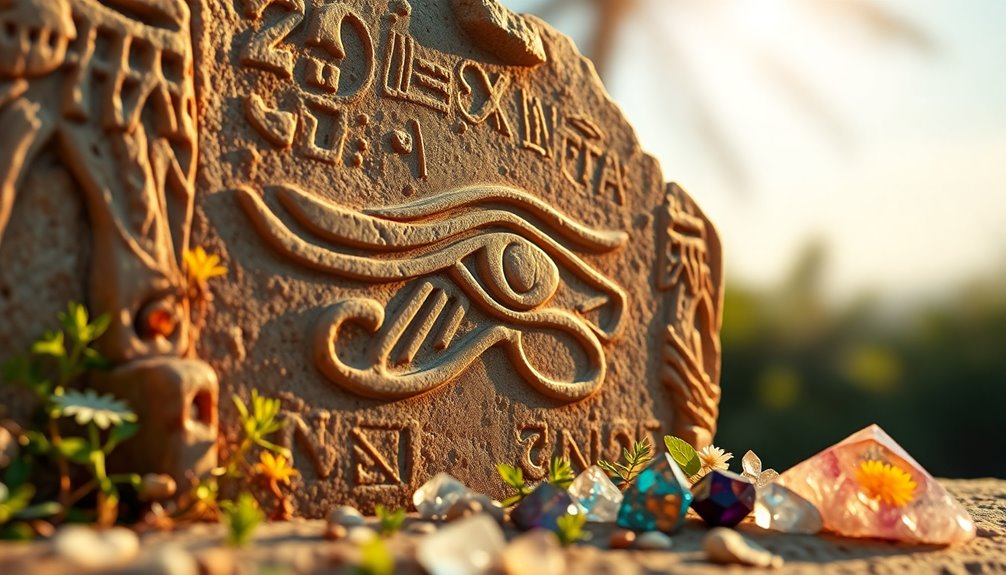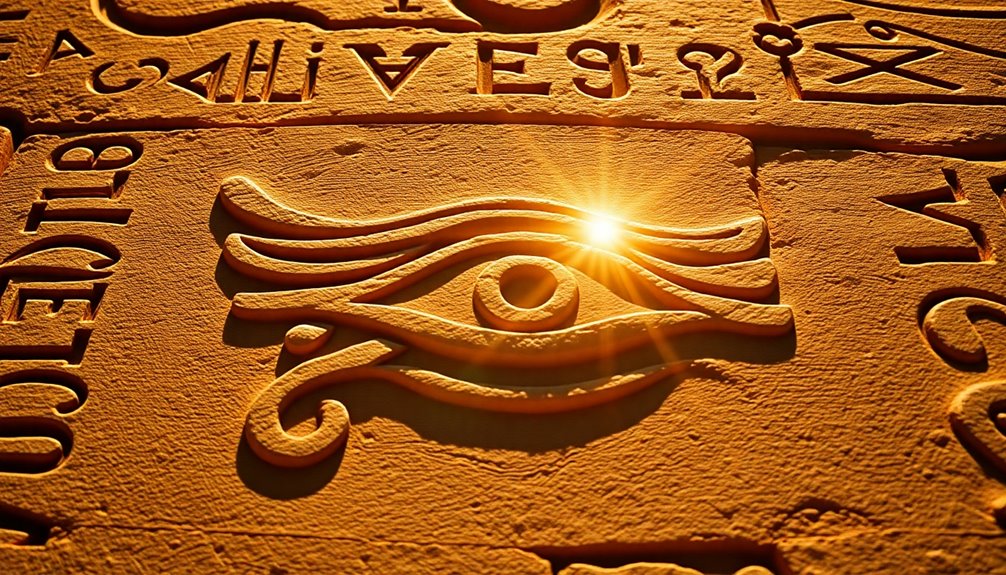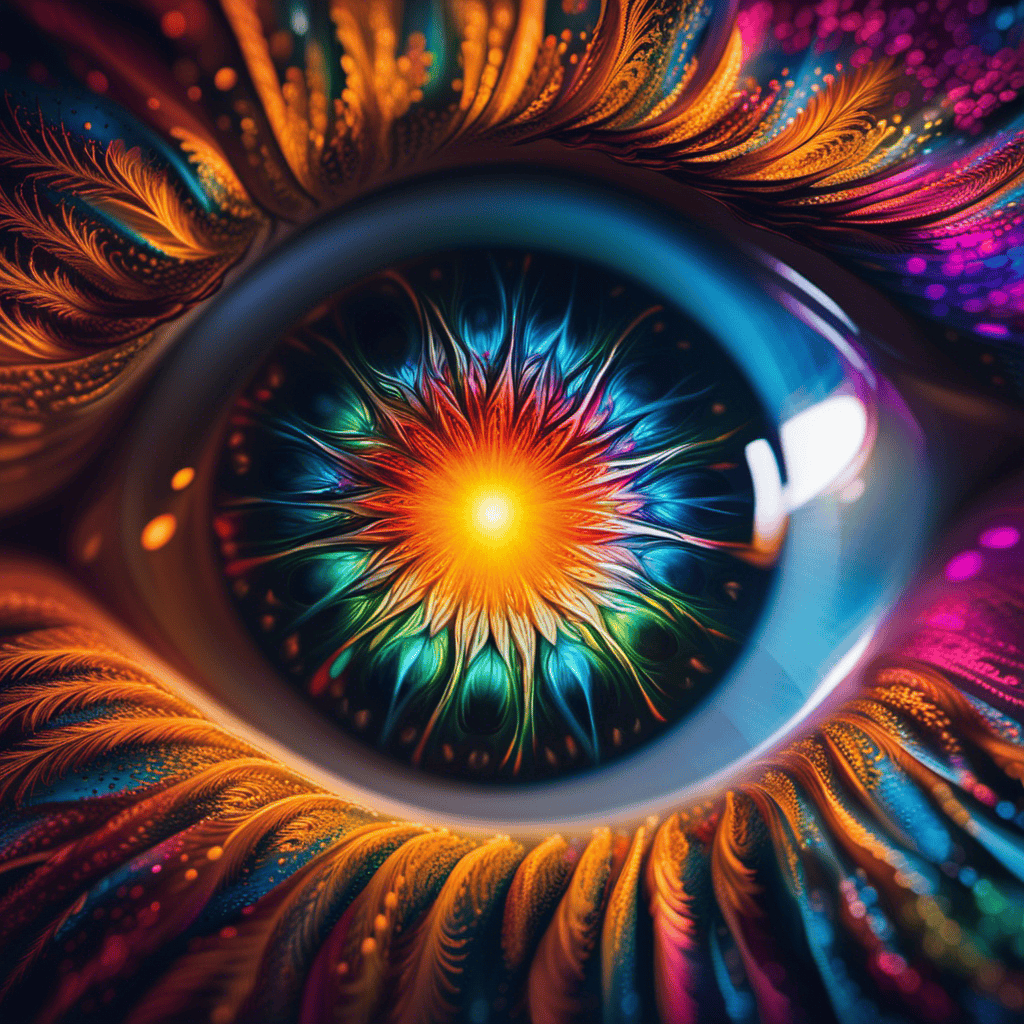The Eye of Horus, known as the wedjat, symbolizes protection, healing, and wisdom in ancient Egypt. It's associated with the myth of Horus's eye restoration, representing completeness and divine safeguarding. Each of its six parts connects to aspects of health and intuition, making it significant for rituals aimed at healing and spiritual well-being. Additionally, it reflects the lunar cycles, showcasing the Egyptians' deep understanding of time and nature. Wearing this emblem can attract good fortune and ward off evil. If you're curious about its deeper meanings and cultural impact, there's plenty more to uncover.
Key Takeaways
- The Eye of Horus symbolizes protection and healing, embodying the ancient Egyptian belief in maintaining health and balance.
- Comprising six parts, it reflects completeness and divine protection, linked to Horus's eye restoration myth.
- It connects earthly existence with celestial cycles, illustrating the ancient Egyptians' advanced astronomical and mathematical understanding.
- The eye represents wisdom and insight, guiding decision-making and spiritual understanding through its association with lunar cycles.
- Crafted into amulets, it served as a powerful symbol for warding off evil and attracting fortune in ancient Egyptian culture.
Symbolism of the Eye of Horus

The Eye of Horus, often recognized as a powerful symbol, represents protection and healing in ancient Egyptian culture. This emblem, also known as the wedjat, is depicted as a falcon's eye with distinctive markings, embodying royal power and safeguarding the wearer.
The Eye of Horus signifies completeness and wholeness, rooted in the myth of Horus's eye being restored after a battle with Set. This restoration emphasizes its role as a potent amulet against evil forces.
The symbol comprises six parts, each linked to a specific sense and contributing to a total of 63/64, representing divine protection and the concept of incompleteness in our physical existence.
Its connection to lunar cycles illustrates the ancient Egyptians' understanding of astronomy, as the Eye of Horus reflects the moon's phases and their influence on life and health.
You'll often find the Eye of Horus in jewelry, art, and funerary practices, serving as a protective emblem intended to guarantee well-being in both life and the afterlife.
Health and Healing Associations

Throughout ancient Egyptian culture, the Eye of Horus was more than just a symbol; it served as a powerful emblem of health and healing. This iconic symbol promoted both physical and spiritual well-being, essential for maintaining balance and liveliness in life. It was frequently used in rituals aimed at invoking healing energies, especially after injuries.
The Eye of Horus also represented the senses, with each part linked to different aspects of perception and healing. Many wore this symbol as an amulet, believing it offered protection from illness and encouraged longevity.
Here's a quick overview of its associations:
| Aspect | Connection | Purpose |
|---|---|---|
| Symbol | Eye of Horus | Represents health and protection |
| Rituals | Healing ceremonies | Invokes healing energies |
| Amulet | Worn for protection | Safeguards against illness |
| Vitality | Represents life energy | Encourages longevity |
| Balance | Central to health in ancient Egyptian belief | Essential for overall well-being |
Astronomical Significance

Often overlooked, the astronomical significance of the Eye of Horus reveals a profound connection between earthly life and celestial phenomena. This ancient symbol serves as a bridge between the lunar and solar cycles, embodying the balance of day and night in ancient Egyptian beliefs.
- Represents the phases of the moon
- Reflects the cyclical nature of life
- Illustrates advanced understanding of fractions
- Tied to the keen vision of the hawk
- Symbolizes restoration of health
Each part of the Eye of Horus correlates to specific fractions, contributing to the Egyptians' mathematical prowess and understanding of completeness. For instance, the pupil represents 1/4, showcasing their skill in measurement and astronomy.
This intricate connection to the phases of the moon and solar cycles emphasizes the Eye's role in tracking time and understanding the natural world. The keen vision of the hawk, associated with the Eye, represents insight into both earthly concerns and celestial domains.
Wisdom and Insight

Recognizing the Eye of Horus's astronomical significance naturally leads to its representation of wisdom and insight in ancient Egyptian culture. This powerful symbol embodies the pursuit of knowledge, encouraging you to tap into your intuition and inner vision.
The Eye of Horus serves as a guide for decision-making, helping you navigate life's complexities with foresight and clarity.
In ancient Egyptian mythology, the restoration of Horus's eye by the god Thoth signifies the pivotal role of wisdom in achieving balance and healing. This connection underscores the importance of spiritual understanding, which allows you to see beyond the physical dimension.
The Eye of Horus is intricately linked to lunar cycles, emphasizing how wisdom aligns with the natural rhythms of life.
Cultural and Spiritual Impact

How has the Eye of Horus shaped cultural and spiritual practices throughout history? This powerful symbol has been central to ancient Egyptian beliefs, representing protection, healing, and an essential connection between the physical and spiritual domains. Its influence is seen in various aspects of life, from art to funerary customs.
- The Eye of Horus as a protective amulet
- Its role in healing rituals and practices
- Symbolism in ancient Egyptian mathematics
- Connection to the afterlife and burial rites
- Continued relevance in modern spiritual practices
As a revered cultural artifact, the Eye of Horus was often crafted into amulets and jewelry, believed to ward off evil and attract good fortune.
In funerary practices, it guaranteed safe passage to the afterlife while promoting health for the deceased.
The symbolism of this emblem extends beyond protection, embodying wisdom and spiritual insight, which still resonates today.
From ancient tombs to contemporary art, the Eye of Horus bridges the gap between past beliefs and modern interpretations, serving as a timeless reminder of the ancient Egyptians' profound understanding of the human experience.
Frequently Asked Questions
What Does the Eye in Ancient Egypt Mean?
The Eye in ancient Egypt, known as the Eye of Horus, symbolizes protection and healing.
When you see it, think of the powerful connection to the divine. It represents the moon and offers physical and spiritual security.
You'll find it in various artifacts and amulets, designed to ward off evil.
This emblem not only signifies completeness but also serves as a reminder of divine insight that resonates even in modern interpretations.
What Is the Eye of Wisdom in Egypt?
When you ponder the Eye of Wisdom in ancient Egypt, you're not just gazing at a symbol; you're touching the essence of protection and insight.
This revered emblem, associated with the Eye of Horus, whispers of healing and divine guidance. It's about intuition and the ability to see beyond the surface.
The ancient Egyptians believed this eye could restore wholeness, inviting you to explore the depths of knowledge and spiritual connection.
Is the Egyptian Eye the Symbol of the Pineal Gland?
Yes, the Egyptian Eye, often referred to as the Eye of Horus, is sometimes seen as a symbol of the pineal gland.
You'll find that both represent insight and higher consciousness. The Eye of Horus embodies protection and spiritual awakening, similar to how the pineal gland is linked to intuition and enlightenment.
What Is the Spiritual Meaning of the Eye of Horus?
The Eye of Horus symbolizes protection and healing in spiritual practices.
It's a reminder to you of the balance between intuition and logic, guiding you to trust your inner wisdom.
When you wear it or meditate on it, you connect with ancient energies that promote renewal and wholeness.
This emblem encourages you to enhance your psychic abilities and deepen your understanding of the spiritual domain, ultimately leading to greater insight and clarity in your life.
Conclusion
In just five minutes, you've uncovered the Eye of Horus's rich tapestry of meaning, where ancient wisdom meets modern relevance. This powerful symbol, representing protection and healing, contrasts with today's fast-paced world, reminding you to pause and reflect. Embrace the insight and clarity it offers, allowing its energy to guide you through life's challenges. As you navigate between chaos and calm, let the Eye of Horus illuminate your path, bridging the wisdom of the past with your present journey.









